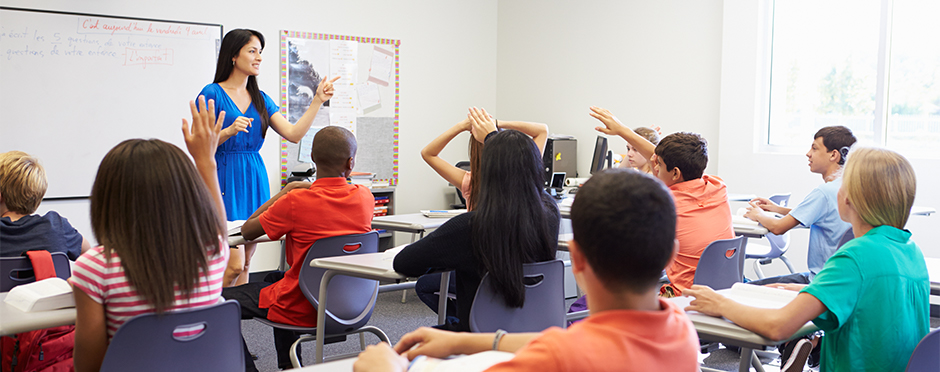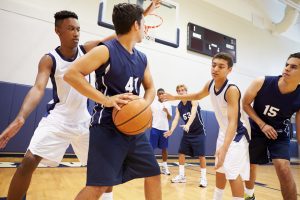
Back to School Safety Guide
1 CommentAfter enjoying months of summer fun, heading back to school can be a difficult transition for kids, whether it’s through an e-learning format or back to the classroom.
From poor posture as a result of sitting in desks all day to sports injuries in student athletes, there are a variety of safety concerns that both parents and kids should be aware of before the first day of school begins. Read below for some tips that can help every kid stay safe this upcoming school year.
For the Bookworm
- Sitting 101: People aren’t meant to sit for long periods of time, so it’s common for students to exhibit poor posture in the classroom or after school when sitting down to finish homework. To reduce lower neck and back strain, keep these tips in mind:
- Keep feet flat on the floor
- Place back firmly against the back of the chair
- Pull the shoulder blades back
- Keep work close to the body
- Choosing the Right Backpack: Heavy backpacks can cause musculoskeletal pain and soreness in students. To prevent this from becoming an issue, it is important to take fit into consideration when picking out a backpack. Parents should look for a backpack with padded shoulder straps as well as a hip or sternum belt to improve balance and reduce strain on upper back and shoulder muscles. It is also important to keep in mind that backpacks should not weigh more than 10 percent of a student’s body weight. Learn more by checking out Athletico’s “4 Backpack Safety Tips” blog.
 For the Social Butterfly
For the Social Butterfly
- Combat Text Neck: With school back in session, kids will be catching up with their friends in addition to their studies. Nowadays kids are opting for their smartphones to keep in touch rather than passing around handwritten notes, which can lead to an unnatural posture that is often referred to as text neck. Text neck occurs when someone hunches over with their head lowered and shoulders rolled forward to look at their phone. This can lead to a variety of injuries that impact the neck, back, shoulders and arms.
Since it’s unlikely that teens will be giving up their smartphones, it’s a good idea to learn exercises that can help counteract pain that can occur with text neck. For step-by-step instructions on how to perform some of these exercises, read Athletico’s “4 Stretches to Help Your Teen Combat Text Neck.”
- Avoid Overuse Injuries: There are other injuries outside of text neck that can occur with the use of technology. For example, taking selfies can result in an overuse injury that causes inflammation in the tendons that run from the hand to the elbow. This has been referred to as “Selfie Elbow.” To help prevent social butterflies from becoming a victim to this and other technology-related ailments this school year, check out Athletico’s “Put Your Phone Down. Your Arms Will Thank You!”
For the Athlete
- Play Multiple Sports: There has been a trend of young athletes specializing in one sport recently, but it may be a better idea to play multiple sports. Data shows that early sport diversification is more likely to lead to valuable physical, cognitive and psychosocial skills for young athletes.1 What’s more, early sport specialization can lead to burnout and increased risk of overuse injuries. Click here to learn more about the benefits of young athletes playing multiple sports.
- Protect Your ACL: One of the most common knee injuries is an anterior cruciate ligament (ACL) sprain or tear.2 To reduce the number of ACL injuries and improve the outcomes for athletes that suffer an injury, Athletico offers the ACL 3P Program, which stands for Prevention, Progression and Performance. This program helps minimize the risk of ACL injury and restores strength and normal mechanics post-ACL surgery. Learn more about this program and the benefits of an ACL risk assessment by reading Athletico’s “Can ACL Tears Be Prevented?”
- Getting Smart about Concussions: With any sport comes the risk of injury, and this includes concussions. For this reason, it is important that athletes, coaches and parents are aware of the signs and symptoms of concussions. Baseline testing should also be considered before the fall sport season begins. This test is used as a resource should a concussion occur, so that the concussed brain can be returned back to the baseline state. Click here to learn more about baseline testing and to schedule an appointment.
For Everyone
- Stay Hydrated: Hydration is an essential part of a healthy lifestyle, but it can be easy for students to forget about this when getting back into the classroom. The guideline that most people follow when it comes to hydration is to drink at least 64 ounces of water a day. However, the recommendations for staying hydrated can actually vary from person to person based on sweat rate. Read Athletico’s “Hydration for Performance and Health” to learn more about how to stay hydrated.
- Get Enough Sleep: Sleep is another key component of living a healthy lifestyle. In fact, the National Sleep Foundation notes that when sleep is cut short, the body doesn’t have enough time to complete all the phases needed for things like muscle repair, memory consolidation and the release of hormones that regulate growth and appetite.3 Click here to learn about additional benefits of sleep.
Get Ready for a Happy and Healthy School Year!
Regardless if a student identifies as a bookworm, social butterfly or athlete (or all of the above!), it is important to take the right steps to ensure a happy and healthy school year. The aforementioned tips can be the first step in making this happen. Should an injury occur at any point throughout this school year, make sure to request a free assessment at your nearest Athletico location.
Free assessments are available both in-clinic and virtually through our telehealth platform.
The Athletico blog is an educational resource written by Athletico employees. Athletico bloggers are licensed professionals who abide by the code of ethics outlined by their respective professional associations. The content published in blog posts represents the opinion of the individual author based on their expertise and experience. The content provided in this blog is for informational purposes only, does not constitute medical advice and should not be relied on for making personal health decisions.
References:
1. Jayanthi N, Pinkham C, Dugas L, Patrick B, Labella C. Sports specialization in young athletes: evidence-based recommendations. Sports Health. 2013;5(3):251-7.
2. “Anterior Cruciate Ligament (ACL) Injuries.”OrthoInfo. American Academy of Orthopaedic Surgeons, 01 Mar. 2014. Web. 02 May 2017. < https://orthoinfo.aaos.org/topic.cfm?topic=a00549>.
3. “What Happens When You Sleep?” National Sleep Foundation. N.p., n.d. Web. 01 Aug. 2017.


1 Comment
Justin L.
SO INFORMATIVE!